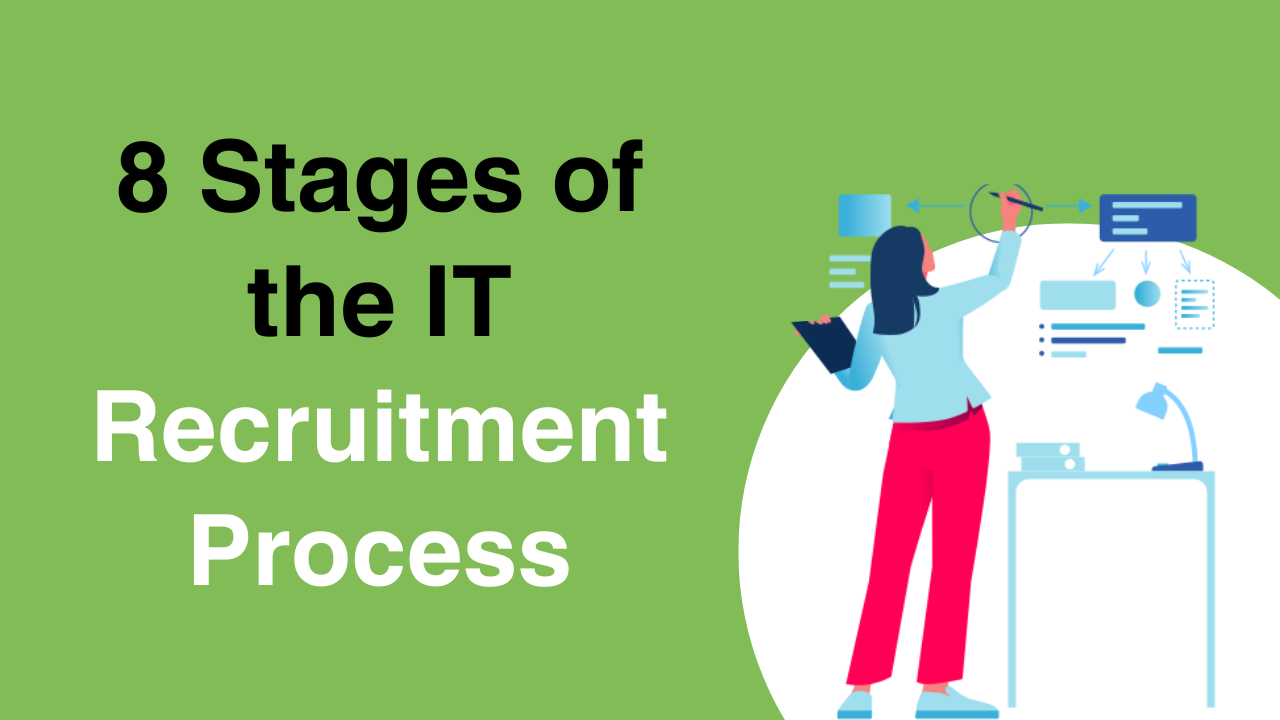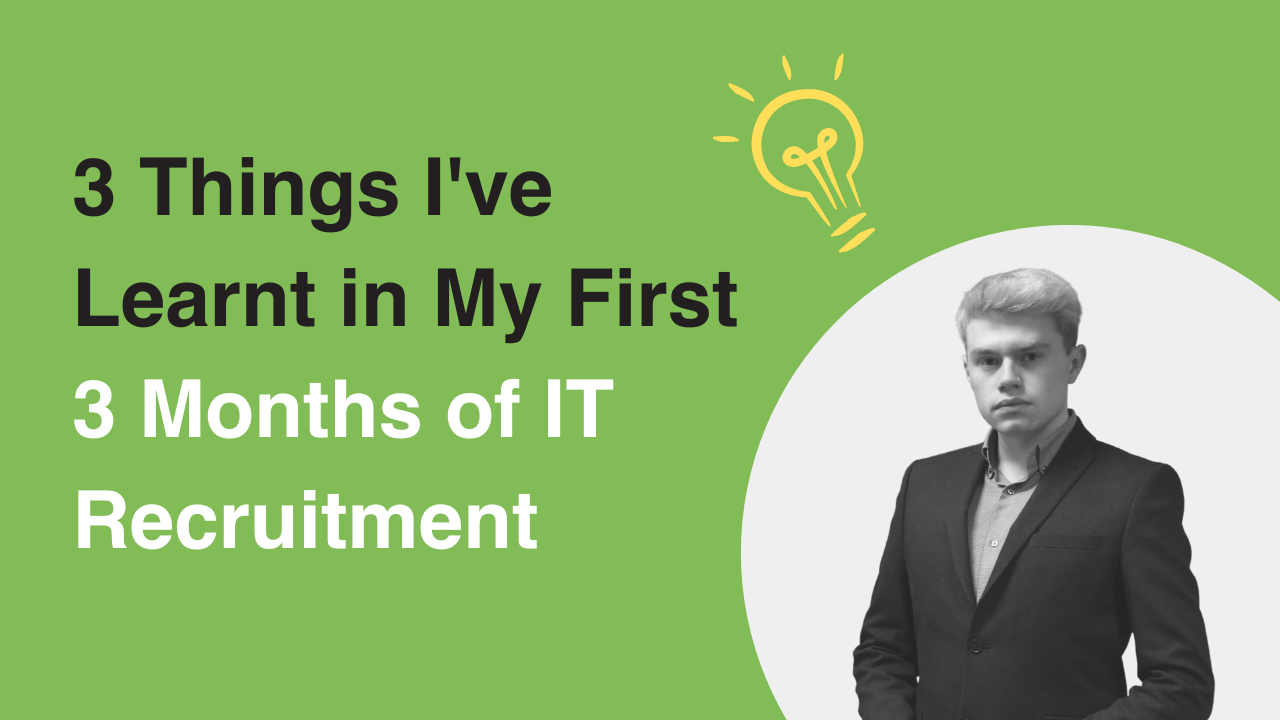In 15 years of IT and tech recruitment, we’ve seen all the ups and downs of the industry, from market booms to the pain of the pandemic. Now the supply of UK talent is finally catching up to demand, according to KPMG’s 2024 UK jobs report.
More IT workers are available — but skills gaps and a lack of diversity still make hiring a challenge. Where can you find the people you need?
At Greenfield, we go through multiple stages of searching and screening candidates for IT roles, including working closely with companies to find out exactly who they’re looking for.
Here’s the inside story of our IT recruitment process, from client consultations to onboarding successful hires.
What is a recruitment process?
The recruitment process is everything that goes into adding someone new to a team, from creating a job description to attracting candidates, sifting through them, finding the right person, and welcoming them onboard.
Every industry has a slightly different recruitment process. IT and tech companies are usually focused on specific technical skills, so assessing candidates’ qualifications is a key part of hiring for IT roles.
Each organisation has unique needs, too. For example, in a big company with many different departments, we’ll need to speak to multiple stakeholders before writing the job description. Some of our clients are looking for culture fit, a candidate for a specific project, or even potential for career growth.
That’s why we use an eight-stage recruitment process. It means that nothing gets missed.
The importance of a thorough IT recruitment process
When recruitment is rushed, then lots of things can go wrong:
- The job description might not attract enough candidates.
- The job description might attract candidates who aren't right for the role.
- In-house recruiters may struggle to source external candidates, even though they're experts on internal hires.
- A candidate might be hired because they have the right skills, but it turns out they don't work well with the team (or vice versa).
Stages of the recruitment process in IT
The recruitment process starts with understanding your hiring needs, from culture fit to skills and experience.
Next, your recruiter will develop a tailor-made strategy to find candidates. At Greenfield, this is the stage that makes us different from other recruitment agencies. Each member of our team is a regional expert in a specific area of the UK. They’ll draw on local knowledge, networks, and contacts to find you the best possible candidates.
When the search is complete, you’ll get the chance to review applications and meet the strongest candidates, interviewing them according to your usual hiring process. The final decision is always up to you.
But that decision doesn’t mean the end of the recruitment process. You’ll still need to make an offer, negotiate, and onboard new hires so that they can do their best work. Your recruitment agency should support you all the way through.
1. Initial contact and identifying hiring needs
The recruitment process starts with a conversation: the first contact between the recruiter and the client.
During the initial contact, you’ll probably be asked:
- What are the vacancies in your organisation? Are you looking for IT department leaders, developers, digital marketers, data scientists, IT support, or something else?
- Do those vacancies already have job specifications? What are they?
- Are there any other gaps in your team (even if you don't have a specific role in mind yet)?
- What skills are needed for each role?
- What experience is needed for each role?
2. Client consultation
Over time, you’ll collaborate with your recruiter more and more. They’ll help you build on that first conversation to define every aspect of your hiring search, from technical qualifications to culture fit.
Trust and honesty are essential to the client consultation. You have to trust your recruiter with sensitive details, such as your team’s strengths, weaknesses, and goals. In order to find the best possible candidate, you’ll have to be honest about your needs.
After all, we expect absolute honesty from candidates when they’re job-searching. Companies owe candidates the same level of honesty about expectations, culture, and what the job involves.
3. Strategic planning
Finding candidates involves a lot more than uploading a post to a job site. Once your recruiter understands what you’re looking for, they’ll develop a strategy to find the best possible pool of candidates.
As part of strategic planning, they might…
- Set up a timeline to find and shortlist candidates.
- Create an advertising strategy for the role.
- Choose sourcing channels, such as different job boards and industry newsletters.
- Use local knowledge to find more sources of candidates.
- Speak to local contacts who could recommend candidates.
4. Talent search: candidate sourcing and attraction
Next, they’ll put the plan into action. Your recruitment team can sit back and relax for a while, as the recruiter searches through job boards, professional networks, and their own database of contacts to find interested applicants.
We aim to get a long list of potential candidates — so that you can choose from the strongest shortlist possible.
5. Screening and shortlisting candidates
When someone expresses interest in a role, they’ll go through screenings to work out whether they’re a good fit for the job responsibilities, goals, and culture.
Just like the job description itself, the screening process for each role will be slightly different. For example, a role which demands highly technical skills might include extra assessments.
Here’s what we usually cover when screening a candidate:
- Resume review. What skills and experience does the candidate have? At this stage, we can choose to prioritise candidates with certain qualifications, or flag any details which we'd like to discuss during an interview.
- Technical assessments. These evaluations might take the form of asking for code samples or inviting the candidate to a live coding session, pair programming session, or simply a technical conversation.
- Other assessments. For some roles, we might use personality assessments to assess working style and culture fit
- Initial interviews. While the final interviews are up to you, a recruiter might conduct early interviews to help guide your choices.
6. Client presentation and engagement
The shortlist from your recruiter will include all the information they’ve collected, including detailed personal profiles and the results of any assessments. When you approve the shortlist, they’ll also help you contact candidates and set up interviews.
This stage of the IT recruitment process will vary between companies and roles. Some teams like to have multiple interviews, so that several people can meet the candidate and form an opinion. Others like to simplify the process as much as possible.
7. Final selection evaluation and offer of employment
Your recruiter will be alongside you all the way through evaluations and interviews. While you get to know the candidate, we’ll be following up references in the background.
A good IT recruitment agency will also look back on the process and talk about how things went. Optimising the process makes it a better experience for both your team and the successful candidate.
And it means that other applicants should still have a positive view of your company — protecting both your reputation and your pool of potential future hires.
At Greenfield, we look at key metrics such as:
- How many people applied for the role? Was our search strategy effective?
- What was the conversion rate for each job advertisement that we posted? Why did some ads perform better than others?
- How do candidates rate their satisfaction with the process? Do they have any specific feedback?
8. Onboarding support
By the end of an IT recruitment process, your recruiter has got to know you — and your new team member — exceptionally well.
So it makes sense that they can help with onboarding: easing communication, clarifying details, and sharing all the information that you need to work successfully together.
Not every IT recruitment agency offers this service, but it can make onboarding significantly easier for everyone involved.
Why should I consider recruitment process outsourcing?
Recruitment can seem mysterious and opaque from outside the process. But once you understand it from a recruiter’s perspective, you can see the extensive work that goes into finding, sifting, and hiring new team members.
It’s also clear that a thorough IT recruitment process takes a lot of time and budget. The average business spends 35 hours a week on recruitment — almost as much as a full-time employee’s working hours.
That’s where outsourcing becomes useful.
The right recruitment agency will take care of the whole process, while leaving the final decision up to you. They’ll have the specialist knowledge to find candidates who are a perfect fit for your sector and business.
Ideally, they’ll even be tapped into local professional networks, so they understand the unique needs for your region.
Get in touch
Greenfield IT has been working with IT companies and professionals for 15 years. Each member of our trusted staff is an expert in their area — so they’ll be able to find the candidates that no one else can.
Start building your team with us today.





